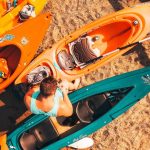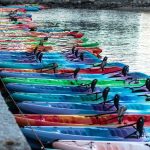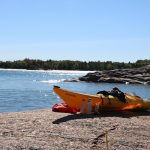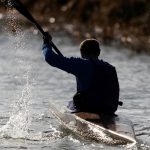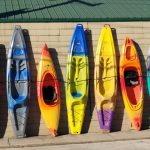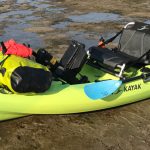So you’ve got your kayak and a bag of gear waiting to get out on the water. Awesome, now let's find a solution for transporting it.
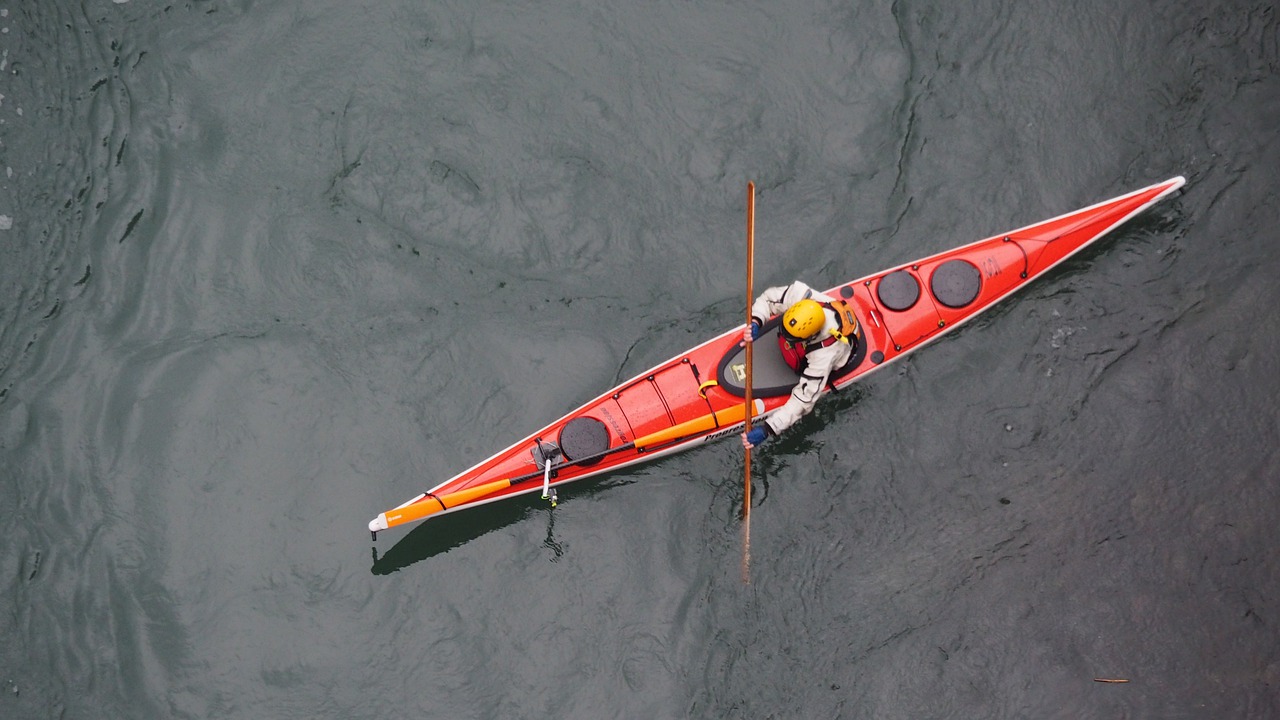
It’s hard to think of a kayak as any more than just that; one solid boat. Okay, so it’s just a boat, but they’re all different, right? There’s some with thin tails, some with huge, bulbous areas.
Some are long and narrow, some shorter and wider, and then there’s some which look impossible to fold yourself into.
Also, why do some of them not have a top half to them?
In this article, we’re going to delve deeper into the anatomy of a kayak and look at some general terminology, as well as some bits which are more specific to particular disciplines. We’ll start off easy and obvious, then get more in depth as we go.
Hopefully, an understanding of anatomy will give you a good basis for what to look for and the differences it can make to your paddling experience.
Dimensions
We’ll start off really easy, dimensions are one of the first things you’ll generally come across when looking at a boat. Okay, it’s easy to understand length, width and height, but why do they matter, and why are some boats an inch or so longer than others, without appearing different in any other way?
Length
Length is measured from the very front of the kayak to the very rear, at the kayak’s longest point. The length of the kayak may differ from the waterline (see further down) but will still determine how fast your kayak can go. A shorter kayak will generally accelerate faster, as in the case of a white water boat, however a longer boat will track more effectively and carry speed over long distances with minimal effort.
Width
Also referred to in nautical terms as beam, the width of the boat is measured across the seat. Wider boats tend to be more stable, while narrower boats are faster and more agile.
Height
Also referred to as deck height, this will determine how much volume there is around your knees. A lower boat can be more susceptible to catching an edge and taking on water, while a higher boat is more affected by crosswinds. A lower boat also pushes you to a different seating position, with wider knees, while a higher boat may get away with being narrower and keeping you knees closer together.
Volume
How much internal space there is in the boat. Internal capacity is also the inherent buoyancy of a boat, when it’s upright and not full of water. In white water boats, this can affect resurfacing abilities after drops or features, while in touring or sea boats it can affect storage. In all boats, the volume affects capacity for paddlers and their equipment.
This volume is distributed around the boat, and some boats with specific designs may have more volume at the bow, or stern, or around the cockpit. Volume distribution is one of the key elements to boat design and has an enormous effect on how the boat is paddled and the environment it’s suited to.
Parts of the Boat
Bow
The bow is the front of the kayak.
Stern
The back of the kayak.
Deck
The top of the kayak.
Closed cockpit or sit-on-top
Sit-on-top kayaks have become increasingly popular in recent years and have made the sport more accessible for a lot of people who were put off by sitting inside the boat. These kayaks tend to be much more stable and often cheaper, and are a great learning platform or family friendly boat.
However, sit-on-top kayaks are also very progressive, and there are white water and surf sit-on-tops which compete with some of the best. They’re also perfect fishing platforms because of their stability and versatility.
A closed cockpit kayak is the traditional shape of the boat, with a circular or oval shaped area for the paddler to sit in. These kayaks, if tipped, can be daunting, but can also be rolled back upright with the right skills (see Basic paddle strokes).
Generally these boats are more progressive and suited to more challenging environments.
Hull Shape and Edges
The hull, the underside of the kayak, is responsible for how the boat itself interacts with the water. This will affect the stability, speed and responsiveness of the boat.
A wide, flat hull will be stable, but susceptible to being blown around by the wind. Meanwhile a narrower, v-shaped hull will track better through the wind, but may feel initially unstable unless you’re moving.
There are benefits to both, and they combine with the edges of the boat, which connect the hull to the deck. These edges may be rounded, or soft, or they may be more square and clearly defined.
Sharper edges will increase the carving ability of a boat, and allow it to make clean, sweeping turns, while softer edges are more forgiving and usually mean you can spin on the spot a little more easily.
The transition section between the hull and the edge of the boat is called the chine. Hard chines make the transition much more abrupt and rely on the boat’s secure edges for secondary stability. Hard chined boats can feel a bit “on or off” when it comes to edging. Softer chines make the transition smoother and give you more of a range when it comes to edging and more primary stability.
For more information on primary and secondary stability, and tracking, scroll down to the “jargon” section of this article.
Cockpit
Like a cockpit on an aircraft, this is the control room of the kayak. Only closed kayaks have cockpits, and it’s where you sit to paddle the boat. There is a cockpit rim which circles the cockpit and is used to hook on a spray deck (see Gear 101).
Grab Handles
Usually positioned at the bow and stern, or on some sit-on-tops, next to the cockpit, these are designed for carrying your kayak as a pair. They are often moulded from the plastic itself, or ergonomically designed to make carrying more comfortable.
On white-water kayaks, these are often made from metal and double as strong points for river rescues.
Keel or Waterline
The waterline, or centreline, is the length of the boat from bow to stern which is in contact with the water itself. This is affected by the rocker of the boat (see below) and the shape of the hull.
Touring kayaks and sea kayaks, as well as some recreational and fishing kayaks, often have a defined keel. A keel is a v-shaped, or on some sit-on-top kayaks a square moulded protrusion, which helps the boat track effectively through the water and limits the effects of drift.
Rocker
On some kayaks, the waterline runs the full length of the boat, and almost the entire hull is in contact with the water. On others, often white water, surf or sea kayaks, there is a section at the bow, and perhaps the stern, which sit out of the water.
This is the rocker profile. By having the front curved out of the water, you can crash through waves and over river features more effectively, and on open water it generally makes for a dryer ride. However, a high rockered bow is affected more by wind and more susceptible to slippage than a long keeled boat.
Technical Features
Seat
The seat in, or on your kayak, will usually be shaped to make it more comfortable, and often padded to make sitting in your kayak more pleasant. Often these seats will come with a backband, or backrest too, which are there to give you more control over your kayak, or to support you and make you more comfortable.
Outfitting
This varies from boat to boat and is additional to the seat, comprises all the pieces of foam and plastic which connect you to the boat. The more connection you have, as in the more of you that’s in contact with the boat itself, the more control you tend to have over the kayak. This takes the form of hip pads, thigh braces and sometimes a riser at the front of the seat.
Some kayaks have little to no extra outfitting, these are usually more recreational, whereas some feel as though you’ve slipped your entire lower half into a foam mould. Sit-on-top kayaks often have detachable thigh straps which act as extra connection and allow you to control the kayak more effectively.
Footrests
Having a comfortable seat and connective outfitting is all well and good, but without a footrest you will just fall into poor posture and slide forward out of your seat. Footrests come in various shapes and sizes, and are designed to give you not only support, but something to drive through with your feet – another effective way to transfer power into your kayak.
Foot pegs are among the most adjustable styles of footrest, and these small plastic pegs are usually on runners down the inside of the boat. They are perfect for recreational or touring style kayaks, but lack the structure needed for white water or aggressive sea kayaking.
Foot blocks, meanwhile, fill the whole width of the boat, meaning you can’t get your feet behind them. This minimises potential entrapment on rivers or churning seas, but they aren’t quite as adjustable as foot pegs. Foot blocks are sturdier and allow you to drive harder with your feet.
Sit-on-top kayaks may have foot pegs, but often have moulded footwells which allow you to quickly move your feet between a relaxed or engaged position without having to move anything inside the boat.
Bung
Often kayaks have a drain bung at the rear, which allows you to empty out any water you may take on in the event of a capsize. These are inefficient for emptying out all the water, but a great way to drain the last few litres before you carry on paddling or lift your kayak onto the roof of your car.
Bulkheads
In longer boats, or boats with internal storage, sealed bulkheads often compartmentalise the space. These are watertight and stop your kit getting wet in the event of a capsize. They also mean that if you do have an out-of-boat experience, it’s much easier to rescue yourself, as much of your boat is still full of air, rather than water. This is especially useful in touring, or sea kayaks, as you may be a long way from shore.
Hatches
Accessing the space behind or in front of the bulkheads is only possible through these hatches. Usually circular, these are sealed with covers which remain in place and watertight even in rough conditions. They can be a fight to get on and off, but you’ll be grateful to know that your overnight kit is staying dry.
Many sit-on-top kayaks also have hatches which access the internal areas of the kayak itself, giving you plenty of space to stow your kit.
Look out for ‘Loading your kayak’ later in the series.
Deck Lines / Other Storage
Deck lines are also used for rescues at sea and are usually attached through multiple strong points on the boat, however there is often bungee strung between deck lines which is ideal for storing items you may want access to on the water, such as spare paddles, water bottles and waterproof cameras.
Other kayaks have storage elements too, for example many fishing sit-on-top kayaks have large storage areas at the stern for boxes, barrels and buckets. These are usually secured with bungee to prevent your kit going overboard.
Skeg or Rudder
A skeg is a deployable fin at the rear of the boat which increases the tracking ability of a kayak. These are common on touring kayaks and some sea kayaks and mean that the boat can be generally flatter and more stable without inhibiting its ability to cover long distances.
Rudder systems, meanwhile, allow you to control these boats without needing to rely on secondary stability and edge-turns, which can be daunting for many paddlers. These are usually controlled by pushing on foot pegs to initiate the turn.
Kayaking Jargon
Some of the words we’ve used might not have made any sense if you’re not a seasoned paddler, so we’ll explain them here.
Primary Stability
The primary stability of a kayak dictates how stable a boat is when sat upright on the water, essentially when a kayak is ‘at rest’. This is usually how recreational kayaks and touring kayaks are paddled and is important to beginners looking for a confidence inspiring kayak.
Secondary Stability
Unlike primary stability, secondary stability is how stable a kayak is when the edges are engaged. This is common in sea kayaking, where edge-turns are a key skill, and white water kayaking, where edges are used to engage with the flow.
Secondary stability varies from boat to boat, and each boat has a point of no return.
Dynamic Stability
Not mentioned previously, but it’s important to understand that, like a bicycle, a kayak is more stable when it’s moving. A sharp v-shaped touring kayak may feel as though it has limited stability when you first get on the water, but once you put in a few paddle strokes and get away from the beach, it feels much more stable.
Tracking
Tracking relates to how effectively a boat will hold its course with minimal steering. A boat which tracks well will not slip in the wind and lose ground.


